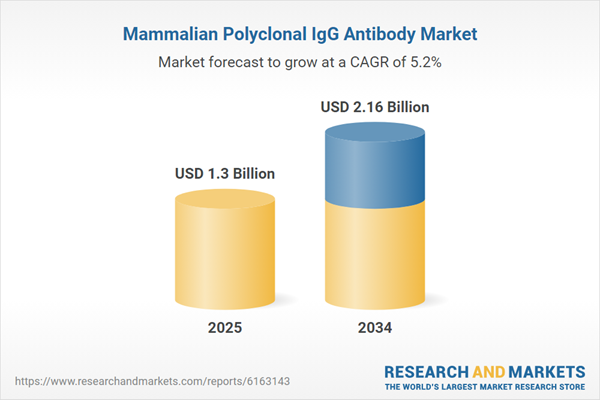Mammalian Polyclonal IgG Antibody: Introduction
Mammalian polyclonal IgG antibodies are a class of immunoglobulins produced by the immune system of mammals, including humans. They are composed of a mixture of antibodies that recognize different epitopes on an antigen. Polyclonal antibodies are derived from the serum or plasma of immunized animals or humans and are widely used in various research, diagnostic, and therapeutic applications. Some of the major features of mammalian polyclonal igg antibodies include diverse specificity, enhanced sensitivity, isotype, natural production, research and diagnostics, and therapeutic applications, among others.Global Mammalian Polyclonal IgG Antibody Market Analysis
The increasing demand for mammalian polyclonal IgG antibodies in research and diagnostics is propelling the market growth as these antibodies are widely used in research, diagnostics, and therapeutic applications. The demand for these antibodies is being driven in many research and diagnostic contexts by the growing emphasis on understanding disease mechanisms, biomarker identification, and personalized therapy. With the rising development of biologics and antibody-based therapeutics, the biopharmaceutical industry is expanding quickly. This is also fuelling the global mammalian polyclonal IgG antibody market growth as these antibodies are essential for preclinical and clinical research on target validation, antibody characterization, and assay development.A study was published earlier this year on MDPI platform about the effectiveness of polyclonal antibodies derived from trans chromosomic bovines vaccinated with the recombinant F1-V vaccine in protecting mice from pneumonic plague. The study shows promising results in increasing bacterial opsonization in vitro and provides hope for potential future treatments. This study also showed potential in reduction of discovery costs by expediting the screening process, reducing the time required for initial evaluation. The study also aimed to use the antibodies as benchmarks to be used later in rapidly screen potential novel antibody therapeutics directed against F1 or LcrV antigens further contributing to the global mammalian polyclonal IgG antibody market share.
Increased investment from both public and private sectors in antibody research and development is driving innovation in the field. Funding initiatives, collaborations, and partnerships are supporting the discovery of novel antibodies, advancements in production technologies, and expansion of antibody-based applications, thereby fueling the growth of the market.
Global Mammalian Polyclonal IgG Antibody Market Segmentations
Mammalian Polyclonal IgG Antibody Market Report and Forecast 2025-2034” offers a detailed analysis of the market based on the following segments:Market Breakup by Product
- Cardiac Makers
- Metabolic Markers
- Renal Markers
- Others
Market Breakup by Applications
- ELISA
- Immunoturbidometry
- Immunoelectrophoresis
- Antibody Identification
- Immunohistochemistry
- Immunocytochemistry
- Western Blotting
Market Breakup by End User
- Hospitals
- Diagnostic Centres
- Academic and Research Institutes
Market Breakup by Region
- North America
- Europe
- Asia Pacific
- Latin America
- Middle East and Africa
Global Mammalian Polyclonal IgG Antibody Market Overview
The biopharmaceutical industry is experiencing significant growth due to the increasing focus on the development of antibody-based therapeutics. The increasing prevalence of chronic and infectious diseases is also driving the demand for research on disease mechanisms, biomarker discovery, and therapeutic methods. The use of therapeutic treatments and biopharmaceuticals has been transformed by monoclonal antibodies. Mammalian polyclonal IgG antibodies nonetheless continue to be very useful in research and development, particularly in the early stages of study, target validation, and assay development.The mammalian polyclonal IgG antibody market demand is influenced by the ongoing improvements in monoclonal antibody development, along with the rising requirement for comparative research using polyclonal antibodies. The importance of personalised treatment choices that are suited to specific patient characteristics is highlighted by the growing emphasis on personalised medicine and precision healthcare.
Advancement in antibody production technologies, including transgenic animal platforms, hybridoma-based approaches, and recombinant DNA techniques, have improved the efficiency, scalability, and quality of mammalian polyclonal IgG antibody production. These technological advancements have reduced production times, enhanced antibody yields, and made mammalian polyclonal IgG antibodies more accessible for research and diagnostic purposes.
Mammalian Polyclonal IgG Antibody Market: Competitor Landscape
The key features of the market report include patent analysis, grants analysis, clinical trials analysis, funding and investment analysis, partnerships, and collaborations analysis by the leading key players. The major companies in the market are as follows:- F. Hoffmann-La Roche Ltd
- Bio-Rad Laboratories, Inc.
- Thermo Fisher Scientific
- Cell Signaling Technology, Inc.
- Merck KGaA
- Genway Biotech
- BioNTech
- Abcam plc
- LigaTrap
- Creative Diagnostics
This product will be delivered within 3-5 business days.
Table of Contents
Companies Mentioned
- F. Hoffmann-La Roche Ltd
- Bio-Rad Laboratories, Inc.
- Thermo Fisher Scientific
- Cell Signaling Technology, Inc.
- Merck KGaA
- Genway Biotech
- BioNTech
- Abcam plc
- LigaTrap
- Creative Diagnostics
Table Information
| Report Attribute | Details |
|---|---|
| No. of Pages | 350 |
| Published | July 2025 |
| Forecast Period | 2025 - 2034 |
| Estimated Market Value ( USD | $ 1.3 Billion |
| Forecasted Market Value ( USD | $ 2.16 Billion |
| Compound Annual Growth Rate | 5.2% |
| Regions Covered | Global |
| No. of Companies Mentioned | 10 |









